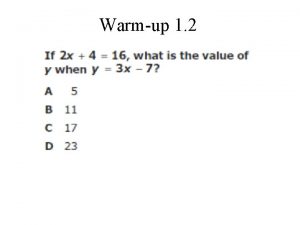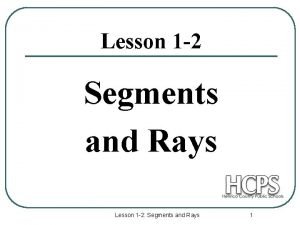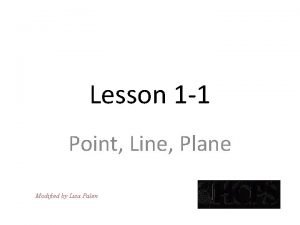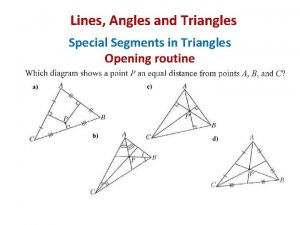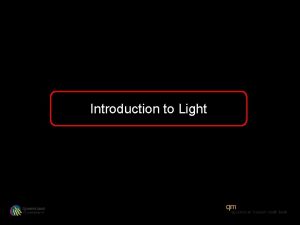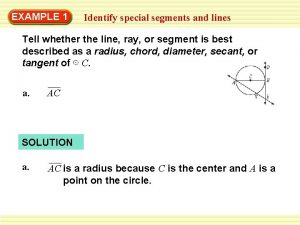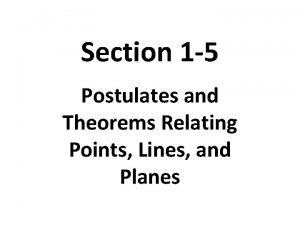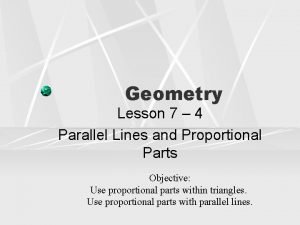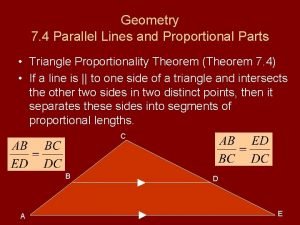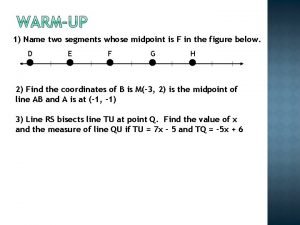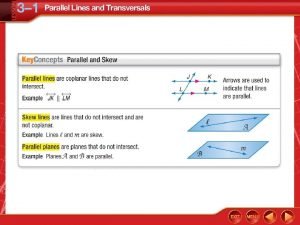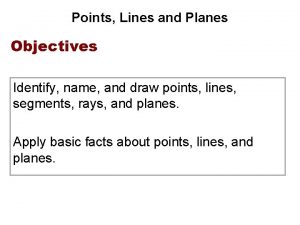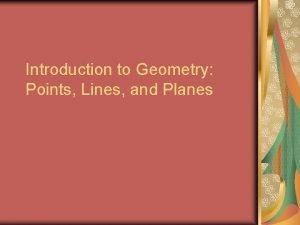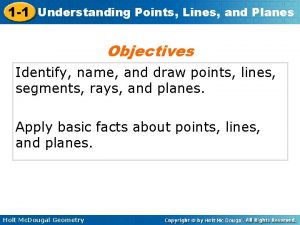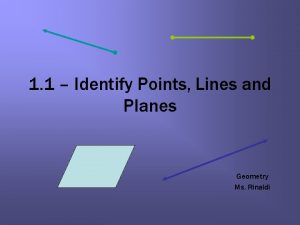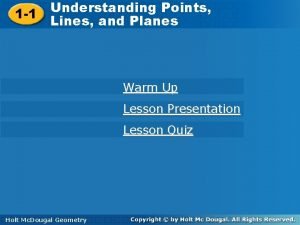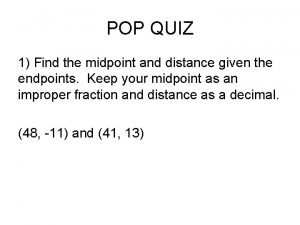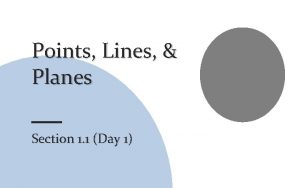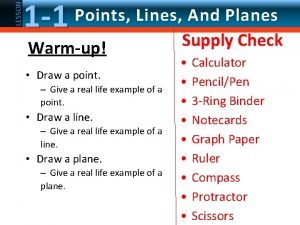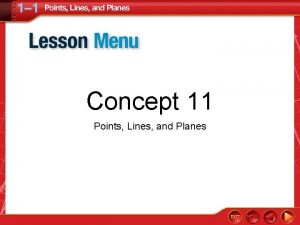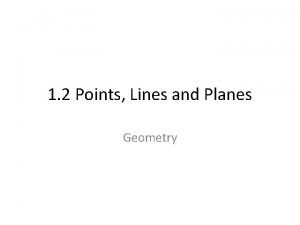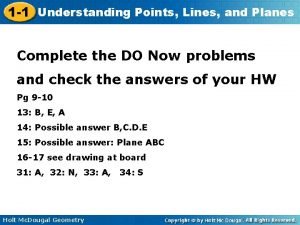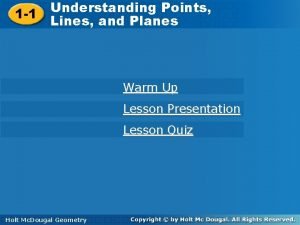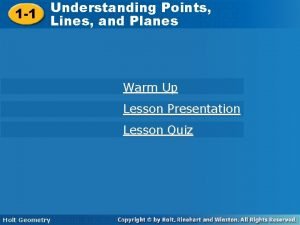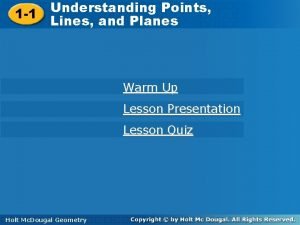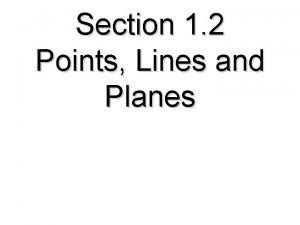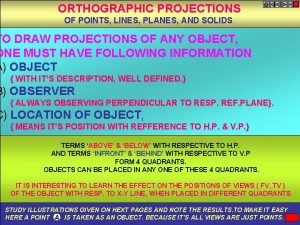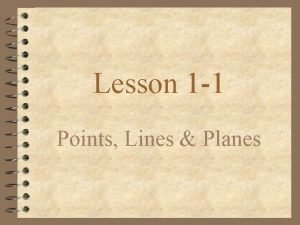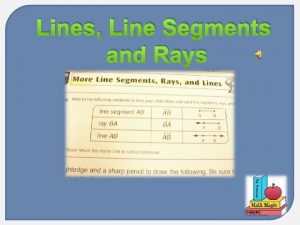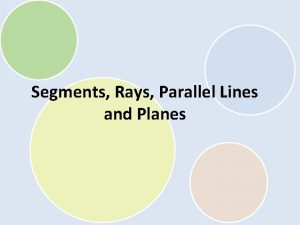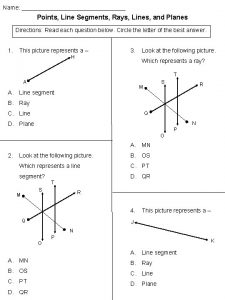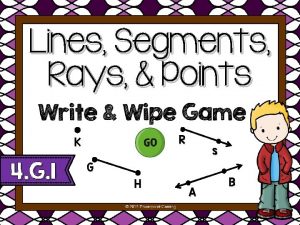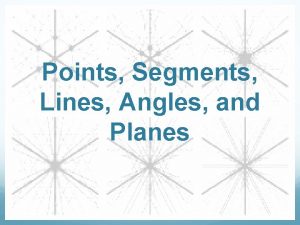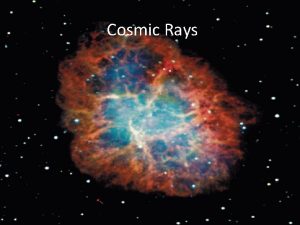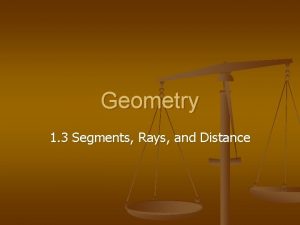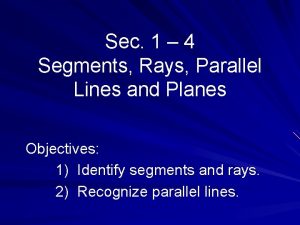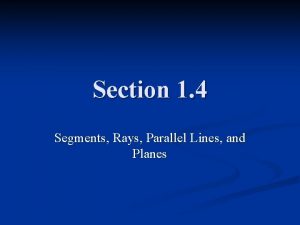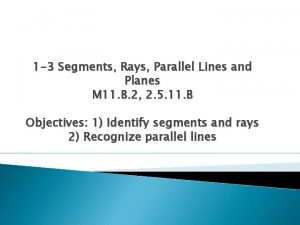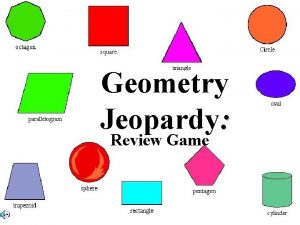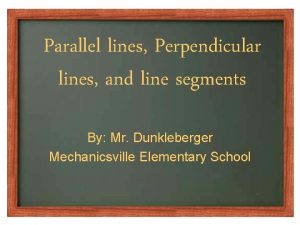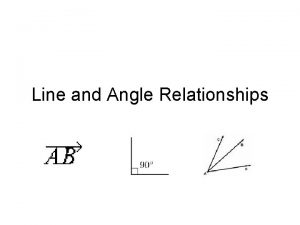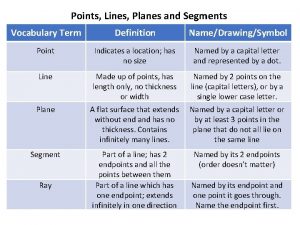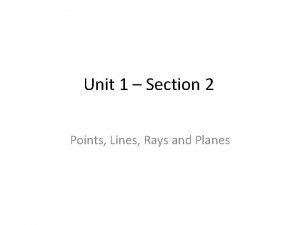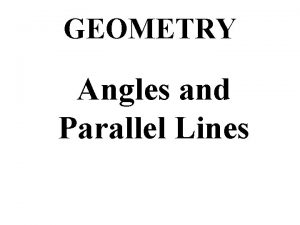I can Name points lines rays and segments







































- Slides: 39


I can… • • • Name points, lines, rays, and segments Name angles Measure angles Self Assessment 5 - I can do it without help & teach others. 4 - I can do this with no help, but I don’t know if I can explain it. 3 - I can do this with a little help. 2 - I can do this with a lot of help! 1 - I don’t have a clue.

Point • A location in space, represented by a dot and a capital letter • Points have no size, only location • D • B D, B and N represent points • N

Your Turn… A T

Line • Continues without end in opposite directions • A • B AB represents a line

Your Turn… R U

Your Turn… R Line RU Line UR U RU UR

Your Turn… B L

Your Turn… B L LB BL

Segment • Part of a line made up of 2 endpoints and all the points of the line between the 2 points • • D E DE represents a segment

Your Turn… A T

Your Turn… A T Line segment AT Line segment TA AT TA

Your Turn… D C

Your Turn… D C CD DC

Ray • Part of a line consisting of one endpoint and extends in ONE directions F • G FG represents a ray

Your Turn… W N

Your Turn… N W Ray WN WN

Your Turn… K G

Your Turn… K G KG

Plane • A flat surface that extends in four directions without end • F • G • H

Parallel • Lines, segments, and rays may be parallel. • Parallel lines go in the same direction and will never cross over each other. • Parallel lines can be horizontal, vertical or oblique. Parallel, Oblique Lines Parallel, Horizontal Segments Parallel, Vertical Rays

Parallel or Not? ? ? NOT PARALLEL

Parallel or Not? ? ? NOT PARALLEL

Intersecting • Lines, segments, and rays may cross over each other. Intersecting Lines Intersecting Segments Intersecting Rays

Intersecting or Not? ? ? Intersecting

Intersecting or Not? ? ? Intersecting

Perpendicular • Lines, segments, and rays may be perpendicular. • When lines intersect and form square corners, we call them perpendicular. Perpendicular Lines Perpendicular Segments Perpendicular Rays

Angles • Angles are formed by 2 rays with the same endpoint (vertex) • An angle can be named 2 ways – 3 letters: a point in each side and the vertex as the middle letter – 1 letter: vertex alone ZYX XYZ Y X Y Z

Measuring Angles A protractor Here is a standard protractor like you use in the classroom.

Measuring Angles You need to make sure the protractor is lined up correctly. Is this ready to measure the angle?

Were you right? . . it wasn’t Look for the upside down ‘T’ in the middle of the straight line on your protractor. This needs to be exactly on the vertex of your angle.

We need to remember. . . It doesn’t matter which way the angle is, you ALWAYS need to line the upside down ‘T’ to the vertex of the angle.

Now you are ready. Read from the 0°, and follow the inner set of numbers.

Once you reach 30° you need to be careful!!! You then need to look at the 1° markings on the outer set of numbers.

What does it measure? This angle measures 35°.

Your Turn… • Measure this angle from the inner scale. • This angle measures 75

Your Turn… • Measure this angle from the outer scale. • This angle measures 100

I can… • • • Name points, lines, rays, and segments Name angles Measure angles Self Assessment 5 - I can do it without help & teach others. 4 - I can do this with no help, but I don’t know if I can explain it. 3 - I can do this with a little help. 2 - I can do this with a lot of help! 1 - I don’t have a clue.

9. 1 -9. 2 Notes INTRO TO GEOMETRY Words Diagram Symbols A line extends without end in 2 opposite directions AB A ray has one endpoint and extends without end in 1 direction AB A segment has 2 endpoints AB Parallel lines go in the same direction and will never cross over each other. Intersecting lines may cross over each other. Perpendicular lines intersect and form square corners Angles are formed by 2 rays with the same endpoint (vertex) X Y Z ZYX Y XYZ
 Opposite rays
Opposite rays Lesson 1-3 segments rays parallel lines and planes
Lesson 1-3 segments rays parallel lines and planes Opposite rays definition geometry
Opposite rays definition geometry Lesson 2 segments and rays
Lesson 2 segments and rays Opposite rays with 4 points
Opposite rays with 4 points Special segments in triangles worksheet
Special segments in triangles worksheet Introduction of light reflection and refraction
Introduction of light reflection and refraction 10-5 secant lines and segments
10-5 secant lines and segments Congruent line segment
Congruent line segment Chapter 10 crafting the brand positioning
Chapter 10 crafting the brand positioning Points of parity and points of difference
Points of parity and points of difference Postulates and theorems relating points lines and planes
Postulates and theorems relating points lines and planes Parallel lines and proportional parts
Parallel lines and proportional parts 7-4 practice parallel lines and proportional parts
7-4 practice parallel lines and proportional parts Name all segments skew to bc
Name all segments skew to bc Name two segments
Name two segments Name all segments skew to bc
Name all segments skew to bc Examples of points lines and planes
Examples of points lines and planes Line drawing algorithm in computer graphics with example
Line drawing algorithm in computer graphics with example Plane geometry real life example
Plane geometry real life example Geometry 1-1 points lines and planes
Geometry 1-1 points lines and planes Ellipse drawing algorithm in computer graphics ppt
Ellipse drawing algorithm in computer graphics ppt Understanding points lines and planes
Understanding points lines and planes Example of opposite rays
Example of opposite rays Understanding points lines and planes
Understanding points lines and planes Distance and midpoint quiz
Distance and midpoint quiz Worksheet 1-1 points, lines, and planes day 1
Worksheet 1-1 points, lines, and planes day 1 Naming a plane
Naming a plane Points lines and planes worksheet answers unit 1 lesson 1
Points lines and planes worksheet answers unit 1 lesson 1 Points and lines in computer graphics ppt
Points and lines in computer graphics ppt How many planes appear in the figure
How many planes appear in the figure 1-2 points lines and planes answer key geometry
1-2 points lines and planes answer key geometry 1-1 understanding points lines and planes answer key
1-1 understanding points lines and planes answer key Understanding points lines and planes
Understanding points lines and planes 1-1 understanding points lines and planes
1-1 understanding points lines and planes Understanding points lines and planes
Understanding points lines and planes Worksheet 1-1 points lines and planes day 1
Worksheet 1-1 points lines and planes day 1 Projections of lines
Projections of lines A line pq 100 mm long is inclined at 30
A line pq 100 mm long is inclined at 30 Plane abc
Plane abc

